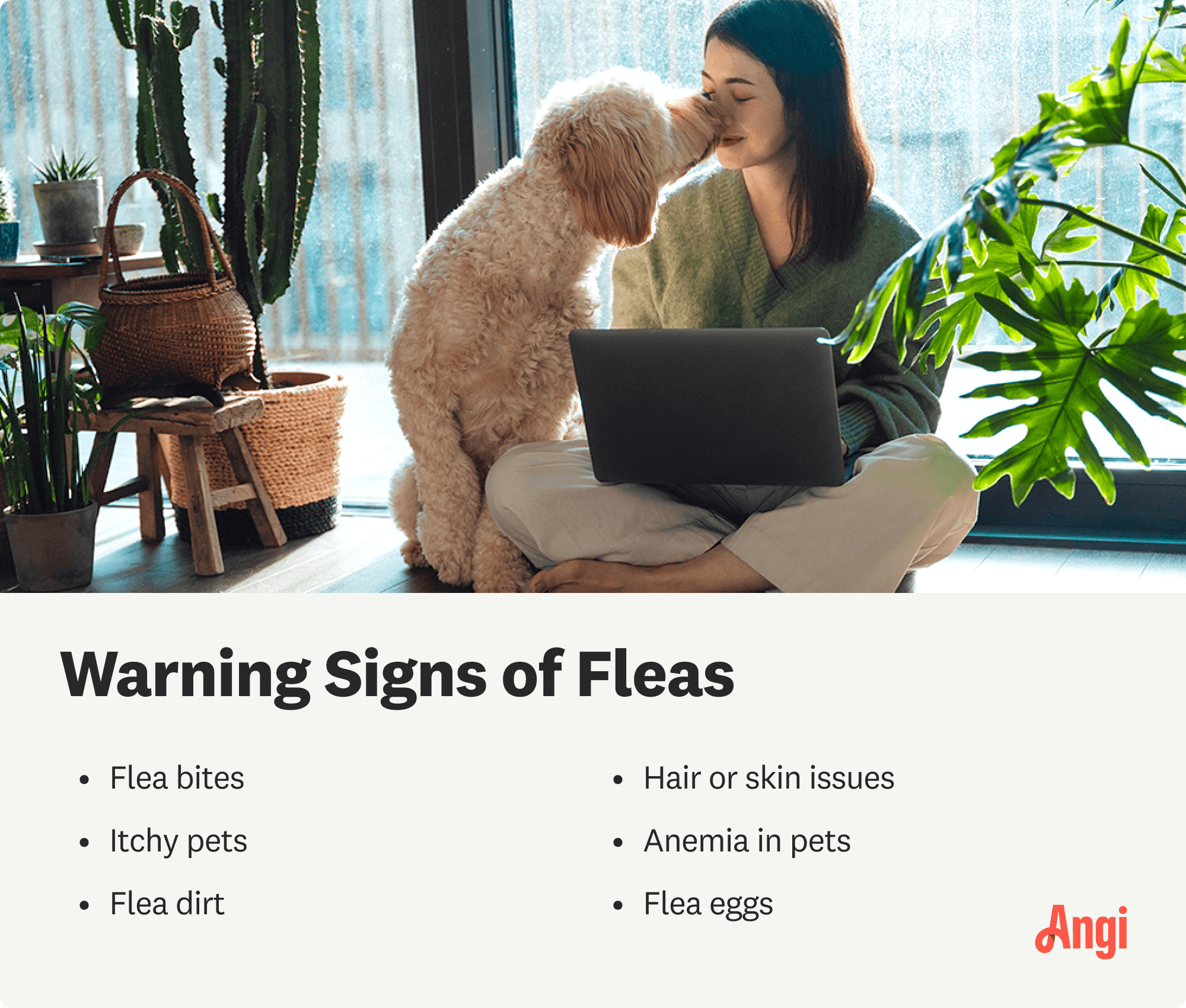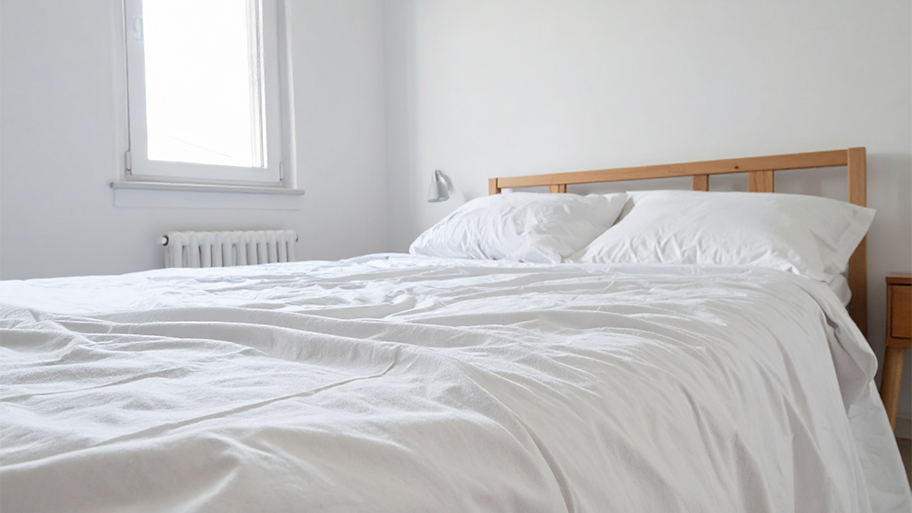
If you need to get rid of bugs and pests making your home unsafe, it's time to decide if fumigation is necessary. Learn more about average fumigation costs.
Keep these tips handy the next time the flea circus comes to town


If you have bites around your ankles or an itchy dog—you may have a dreaded flea infestation. Luckily, learning how to get rid of fleas and tackle the problem head-on is not too difficult.
We've broken down how to get rid of fleas in your house into several options, but it's important to note that they should work in tandem. For example, cleaning your home, sheets, and furniture should coincide with shampooing your dog. The quickest way to kill fleas in your home is to catch as many of the current adult and young fleas in one fell swoop, wait several days, and repeat the process. Let’s review how to get rid of fleas in your home.
If your flea problem doesn't resolve itself after implementing DIY removal methods, it's time to call in a professional exterminator. Don't hesitate to take pest control action to prevent the infestation from growing.
Fleas can multiply quickly and live a shocking average of 100 days, so there's no question how they expand into an infestation. In most cases, fleas will enter your home:
On your pet
On your shoes and clothing
In old furniture or rugs
Through the cracks in your house
From an infested yard or garden
To kill fleas around your home, you can opt for an insecticide that contains permethrin to kill adult fleas, plus an insect growth regulator such as pyriproxyfen or methoprene to kill flea eggs, larvae, and pupae. These are extremely toxic to humans and animals, so you should use them in a contained space that’s out of the reach of pets and children.
If you want ways to kill fleas naturally, salt and baking soda can dehydrate the fleas’ bodies, killing them within a day or two. The bugs are also sensitive to high heat and soap, making steam cleaners, hot water and detergent, and hot cycles in the laundry extremely effective at killing them.
Unfortunately, it’s no easy task to get rid of a flea infestation in your home. Once treatment begins, it could take between a few days to several months to make your home flea-free, depending on the extent and location of the infestation.
Since fleas reproduce quickly and have a long lifespan, more than one treatment is usually necessary. Some fleas are resistant to initial treatments and may lay eggs that will hatch after your first treatment. For severe infestations, you’ll likely need one or two months worth of treatment to fully eradicate fleas.
You may need to repeat these steps many times over the course of several weeks before the infestation clears up.
If you find them on your pet, your first step should be to consult with your veterinarian to help determine the best flea treatments. These can include topical treatments, oral medication, or flea collars that can kill fleas immediately and prevent them from coming back. Along with that, flea shampoos are specially formulated to kill fleas on contact.
Fleas will hide in dark, warm, and soft places around your home. Just as your cat likes to lay across your head at night, if Fluffy brought fleas into the bed, these bugs will enjoy napping on your pillow, too.
Strip all beds and furniture of sheets, blankets, and pillow covers and wash them in warm to hot water with detergent. Detergent and dish soap will kill fleas, so you don't need to run out and grab something extra.
Don't forget to clean pet beds or other areas they frequent, such as in closets or under beds. If a pet bed does not have a removable cover, it may be worth tossing and getting a new one once your flea problem has passed.
While the removable soft goods are in the wash, break out the vacuum cleaner. Use a strong vacuum to cover the whole house, not just the carpets. Vacuum in the corners and behind doors, furniture, and appliances.
Always remember to empty the bag or vacuum container outside your home and into a closed garbage bag after vacuuming. Fleas will not always die during the vacuuming process and can escape your garbage or vacuum.
If your rug and furniture allow it, we recommend renting a steamer as well. Steam cleaning a carpet costs between $50 and $75 for the rental and supplies. Always check the fabric tags on your carpet and furniture before breaking out the steamer: Only fabrics with a "W" or "S/W" can handle water-based solutions and steam.
Diatomaceous Earth (DE), is a fascinating natural substance that kills many insects. The product comes in a white powder or concentrated liquid that contains minuscule fossils of ancient aquatic organisms. Food-grade DE is safe to use in the home around pets and children, though it can cause slight lung, eye, and skin irritation in some sensitive parties. If you're concerned about exposure, close off the area to pets during treatment.
By spreading DE in areas where fleas wander, the sharp powder will scratch open the insect's exoskeleton and dry it out. You’ll likely have the most success with this method if you do it after your initial house cleaning. Here's what to do:
After the first pass with the vacuum or steamer, spread a thin layer of DE on carpets, under furniture, and around the edges of rooms where fleas have been found.
Leave the DE there for several days.
Vacuum up the DE and, hopefully, many dead fleas.
Salt works similarly to DE to dry out the exoskeletons of fleas. When exposed to the crystals, the fleas will slowly die. Since the process can take some time, use salt as an extra measure after performing a deep clean.
Sprinkle fine-grain table salt on furniture, carpets, and over mattresses.
Allow the salt to sit for one to two days.
Vacuum up the remains of the salt and repeat until no further fleas are found.
After a thorough cleaning and pet treatment, catch additional fleas by leaving a simple homemade trap in areas where you've spotted them. Add a few drops of dish soap to a bowl of water and leave the bowl in several inconspicuous and flea-prone places. The fleas will travel into the water and become trapped by the viscous soap.
Keep in mind that this trap must be used in tandem with other methods if you currently have fleas. You can also use it to test if you still have fleas. Always keep bowls of soap in areas where your dog and cat will not lap it up.
Since fleas can spread quickly and survive many natural treatments, a commercial product may be necessary. If you do opt for an insecticide, always use one that is safe to use around pets and children or when you can vacate the house for several days. Be sure to follow all safety tips included with the traps or sprays, like working in a well-ventilated area and wearing safety equipment like gloves.
Chemical traps will likely include an insect growth regulator to catch the fleas at all stages of their development. They may come in the first of bait or powders that you sprinkle right on carpets, floors, and mattresses. Simpler traps, such as sticky traps and eclectic traps, are best used in tandem with other methods, similar to our bowl and soapy water trick.
A flea fogger—or a flea "bomb" or aerosol insecticide—fills a room with a spray that penetrates all areas where fleas could be hiding. The method is best for extreme cases of flea infestations and only when you can leave the house or room undisturbed for the time noted on your given bottle.
Never allow children or pets near the area until the area is clear of the chemical. It is also crucial to wear protective repository, eye, and skin protection when setting off the fogger.
As extreme as the instructions may sound, a flea bomb is one of the quicker ways to get rid of fleas in your home, especially if they've spread far and wide. If you have any doubts you can use this product safely, though, you should absolutely call in a local flea control pro.
Your yard can be prime real estate for fleas when they have an animal host and a place to hide. Frequent animal visitors, piles of brush, overgrown thatch, and standing water can all contribute to outdoor flea infestations.
If you suspect that fleas are entering your home from the outside, work with a local landscaper to balance the ecosystem of your lawn to get them under control. The experts may recommend:
Mowing your lawn at a specific height
Removing leaf, wood, or brush piles
Removing lawn tools, toys, and clutter
Discouraging animals from entering your lawn
Treating the grass with a mild insecticide or with dish soap
Controlling thatch and moisture
Building a small barrier between your lawn and your home
The complex life cycle of the flea makes it very challenging to eradicate an infestation, as certain stages make them more resistant to insecticides and other treatments. To effectively get rid of fleas in all stages of their life cycle, it is crucial to follow up with additional treatments within five to 10 days after the initial application. This will help ensure that any newly-hatched eggs or juvenile fleas are also wiped out.
Alongside direct flea treatments, it’s also important to regularly vacuum and sanitize your home to catch any remaining eggs and young fleas. By implementing these measures consistently, you increase the likelihood of successfully eradicating all the fleas in your home.

Identifying an infestation can be complicated, especially when you're trying to determine what bug is biting you. Your first instinct may be that you have a bed bug infestation. And while it's important to check for bed bugs in your house, if you're suspicious it’s something else, a flea infestation will have some key differences. For example:
Fleas have thin, long bodies while bed bugs are flat and round.
Fleas are about ⅛ inch long, larger, and easier to see than bed bugs.
Fleas can leap very high while bed bugs do not jump or fly.
Flea bites collect around your ankles and legs while bed bugs bite anywhere on your body.
Finding flea bites on your body is the most obvious sign of a flea problem, but you should also check your pet regularly. Excessive scratching, red bites under their skin, or "flea dirt"—aka flea waste—are all clear signs you’re dealing with these pesky bugs. You may also find small black specs of flea dirt around your home, especially in soft areas like rugs, curtains, and sheets.
According to data from Angi customers, 64.4% of people hire pest control services within one week of noticing an infestation. Another 7% of people hire within one to two weeks. Since fleas reproduce quickly, you should call a pro ASAP instead of waiting.

Cleaning is your best defense against flea infestations at home. Maintain a regular cleaning checklist that includes washing your bedding, curtains, carpets, floors, and furniture often, especially after an infestation.
In the same vein, keep a close eye on your pet after they've been targeted as the host. Speak with your vet about the best way to follow up with flea care, especially in the days and weeks after the first treatment.
Here are some additional tips for keeping fleas away for good:
If you do not have pets at home—as they can be toxic to cats and dogs—spray a potent flea deterrent such as heavily diluted lemon, eucalyptus, or rosemary essential oils in flea-prone areas. The solution should contain a few drops of essential oils per spray bottle.
If you do have pets, look for pet-safe sprays with similar scents at your pet store made from ingredients that will not affect your furry family members.
Limit your pet's time outdoors in tall grasses and check them for fleas before coming inside.
Steam clean your furniture and rugs on a regular schedule after an infestation.
Seal up cracks in your home, including in screens and around doors.
Address potential fleas the moment you find a bite on yourself or your pet.
Scent can be a powerful tool for keeping bugs away from your home, and fleas are no exception. Here are a few scents that fleas generally dislike:
Citrus (orange, grapefruit, lemon)
Citronella
Cedarwood
Lavender
Lemongrass
Eucalyptus
Peppermint
Geraniol
To harness the power of these pungent scents, add a few drops of essential oil to a spray bottle filled with water and use it around your home. Beware of using essential oils around your pets, as many are toxic whether they’re inhaled or ingested. Always consult with your veterinarian before using any essential oils on or around your pets, as individual sensitivities and health conditions can vary.
If you’re wary of spraying essential oils you can place fragrance sachets in bug-prone areas, or growing lavender or eucalyptus plants in pots around your home.
The long lifecycle of a flea can make them difficult to eradicate on your own. If you suspect a severe infestation, hire a professional pest control team to create a long-term plan. A specialist will be able to target the adult, larva, pupa, and egg stages, even if the fleas are resilient against common insecticides.
The cost to exterminate fleas will range from $75 to $400, depending on whether you need a one-time visit or ongoing services. Remember to add on the cost of vet and pet treatment services if you have a furry friend at home.
To determine how to get rid of fleas in your house fast, we recommend calling a professional while beginning the DIY steps on our list to get ahead of the issue. Working as a team with your pest control expert is a sure way to nip it in the bud.
From average costs to expert advice, get all the answers you need to get your job done.

If you need to get rid of bugs and pests making your home unsafe, it's time to decide if fumigation is necessary. Learn more about average fumigation costs.

It’s important to know bed bug treatment costs if you have an infestation. Our guide covers different treatment methods and cost factors to eliminate these pests.

Unfortunately, ticks can spread diseases to both you and your pets. Find out how much it will cost to treat your property for ticks.

Learn the most common signs of carpenter ants and where to look for them in the house. We cover costs to remove them and prevention methods in our detailed guide.

Discover effective methods for how to get rid of birds. From cleaning your yard to adding decoys, learn about humane strategies to shoo avian guests.

From the hooded skunk to the Eastern spotted skunk, learn how to identify common types of skunks you may see in your backyard or digging through your trash.